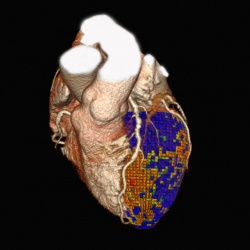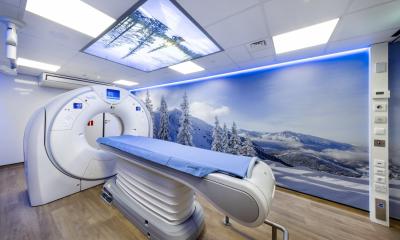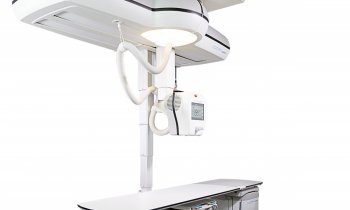Toshiba presents advances in Cardiac Imaging at ESC 2012
Cardiology is playing an increasingly important role in today’s healthcare environment and, as a direct result, cardiologists are facing new challenges almost every day. Addressing the need of improving clinician confidence and diagnostic accuracy, Toshiba Medical Systems Europe presented two symposia on the first day of the European Congress of Cardiology, to be held in Munich, Germany, 25-28 August 2012.

The first session – “Latest update on 320-row computed tomography and its clinical results” - was chaired by Dr Jens Linde (Rigshospitalet Copenhagen, Denmark) and Prof. Stefan Möhlenkamp (Moers Hospital, Moers, Germany). Prof. Joa A.C.Lima, John Hopkins Hospital, Baltimore, introduced into the "CORE320 study design". CORE320 is a prospective, multicenter, multinational study which is unique in that it is designed
to assess the diagnostic performance of combined 320-row CTA and myocardial CT perfusion
imaging (CTP) in comparison with the combination of invasive coronary angiography and SPECT-MPI. The trial is being performed at 16 medical centers located in 8 countries worldwide. CT has the potential to assess both anatomy and physiology in a single imaging session. The co-primary aim of the CORE320 study is to define the per-patient diagnostic accuracy of the combination of coronary CTA and myocardial CTP to detect physiologically significant coronary artery disease compared with (1) the combination of conventional coronary angiography and SPECT-MPI and (2) conventional coronary angiography alone. If successful, the technology could revolutionize the management of patients with symptomatic CAD.
Dr Jens Linde, Rigshospitalet, Copenhagen, gave lecture on "Myocardial Perfusion". CT Cardiac Imaging, so far, is hampered by limitations in quantifying cardiac tissue decreased functionality caused by obstructed coronaries and/or infarcts. In order to visualize the entire heart, conventional scanners need to move the patient during scanning resulting in undesired limited coverage and, time-delayed contrast distribution over the heart. The unique 16cm z-axis coverage of the Aquilion ONE™, allows iso-phasic, at a single moment in time, scanning of the heart, resulting in temporal homogeneous imaging of the contrast distribution.
Myocardial Perfusion is interpreted by comparing rest and stress data where the rest scan is performed using a low dose, prospective, CT angiography protocol. After administration of a pharmacological stress agent, a comparative second low dose stress scan is performed. Pending body mass index and heart-rate, sub-mSv protocols may be applied for both scans.
Dr Sujith Seneviratne, Clayton, Australia, spoke about "Chest pain triage with 320-row computed tomography and dose reduction strategies - AIDR 3D". Chest pain represents an important global challenge, accounting for more than 6 million ED presentations at a cost of over 6 billion dollars in United States alone. Recent studies utilizing Cardiac CT to triage acute chest pain have drawn considerable interest due to its high sensitivity and negative predictive value in excluding obstructive coronary disease and thus acute coronary syndrome. Data supporting the use of Aquilion ONE in this setting will be demonstrated highlighting the safety of discharging after a single troponin in patients with no demonstrable coronary artery disease. Exposure to multiple radiological procedures may increase life time risk of malignancy. Last few years have seen significant improvements in radiation dose for cardiac CT due to various technological advances. The second half of the talk will be devoted to the success AIDR 3D technique utilized by Toshiba to significantly reduce radiation dose without compromising high image quality.
Dr Victoria Delgado, Leiden University Medical Center, delivered a lecture about "320-row computed tomography to guide percutaneous valve replacement". Transcatheter valve implantation has been an important therapeutic breakthrough in the last decade. More than 40,000 patients with severe symptomatic aortic stenosis have been treated with transcatheter aortic valve implantation. In addition, several transcatheter mitral valve repair techniques have been developed to provide a feasible and safe therapeutic alternative for patients with severe mitral regurgitation. Accurate patient selection and procedural guidance are crucial to optimize the outcomes of these therapies. Aquilion ONE permits visualization of the aortic or mitral valves from unparalleled planes, accurate assessment of the dimensions and geometry of the aortic root and mitral valve complex and precise evaluation of the anatomical relationship with surrounding structures. In transcatheter aortic valve implantation, accurate assessment of the aortic valve annular dimensions is crucial to select the prosthesis size whereas the assessment of the peripheral arteries and aorta will indicate the procedural approach. In transcatheter mitral valve repair, indirect mitral annuloplasty with implantation of a cinching device in the coronary sinus, requires exact assessment of the anatomical relationships of the coronary sinus with the mitral annulus and the circumflex artery to optimize the results and minimize complications. These and other aspects can be comprehensively evaluated with Aquilion ONE.
27.08.2012











